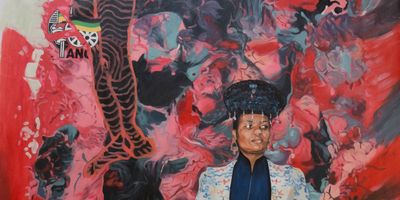Spotlight: Fonseca and Mokgata's Artworks Explore Past and Present Societal Traumas
Get familiar with the work of South African visual art duo Carla Fonseca and Nthato Mokgata.
In our 'Spotlight' series, we highlight the work of photographers, visual artists, multimedia artists and more who are producing vibrant, original work. In our latest piece, we spotlight Carla Fonseca and Nthato Mokgata, a Johannesburg-based South African duo whose multimedia visual artworks explore historical and current societal traumas in South Africa. Read more about the inspirations behind their work below, and check out some of their stunning visual works underneath. Be sure to keep up with the duo on Instagram and Facebook.
Their responses have have been edited for length and clarity.
Briefly describe your background as an artist and what led to you creating art.
Mokgata: I have always loved visual art since I was young, and despite always having fun with drawing, I thought it was not for me. I would doodle and draw and think how terrible my work was in comparison to my peers. It was only after dropping out of med school that I decided to dedicate myself to various forms of art and developed my visual art through graphic design work.
Fonseca: I've been creating art all my life. I use many different mediums to achieve my objectives namely such as theatre, film and performance art. This is my first time openly sharing my love for creating fine art.
What are the central messages or themes underpinning your work?
Mokgata: My artistic practice is focused on challenging notions of the "black aesthetic", history, self-determination, nationhood, identity, and pan-Africanism. I use my art to express the perspectives of a highly innovative, tech savvy and highly traumatised generation of South Africans. I consider the function of my work to be social therapy; to confront our collective trauma and find healing through the manipulation and transcendence of aesthetics.
Fonseca: My work is often based on a struggle to see the end of all forms of gender-based violence in our society. Stylistically, our work addresses themes of aesthetic politics, language and hierarchy, history and the power dynamics surrounding historical presentation, migration, power and violence as a language in culture. We explore painful and dark themes that are symptomatic of our society; while also reaching for a better reality. We use our work as an antidote to denialism in our society.
What would you describe as your best work thus far?
Mokgata: It is hard to pick a favourite, as I think the different works and series have vastly different merits, but I have been enjoying Umama Uyakhala a lot lately. In referencing the Black Madonna, Umama Uyakhala––a meditation on SA's repugnant culture of gender-based violence––calls on a universal and ageless vision of the long-suffering, responsible, loving and devoted mother. A highlight of Marian devotion, the original icon of the Black Madonna goes back to medieval tradition, and possibly further back.
Fonseca: Tough question but I'll highlight one of our works that means a lot to me––the portrait of Fezekile Khuzwayo. She is kind of a martyr of our failed state, a representative of so many women who have suffered the injustices of violence and lawlessness in our country. It's a dedication to a woman I respect with all my heart and in some way, a portrait of my own trauma.
- Spotlight: Akintayo Akintobi's Impressionist Paintings Are Steeped in ... ›
- Nicole Rafiki's Visual Art is Challenging Stereotypes - OkayAfrica ›
- Spotlight: Adekunle Adeleke Creates Digital Surrealist Paintings ... ›
- Spotlight: Sinenhlanhla '99perspective' Chauke Creates Scenic ... ›
- This Kenyan Artist Imagines Sending the Maasai People Into Space ... ›
- Spotlight: O'kiins Howara Creates Technicolor Images of His Surroundings With a Smartphone - OkayAfrica ›
